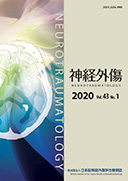Volume 43, Issue 1
Neurotraumatology
Displaying 1-9 of 9 articles from this issue
- |<
- <
- 1
- >
- >|
Original Article
-
Article type: research-article
2020Volume 43Issue 1 Pages 1-4
Published: June 30, 2020
Released on J-STAGE: June 30, 2020
Download PDF (972K) -
Article type: research-article
2020Volume 43Issue 1 Pages 5-12
Published: June 30, 2020
Released on J-STAGE: June 30, 2020
Download PDF (7690K)
Case Report
-
Article type: case-report
2020Volume 43Issue 1 Pages 13-16
Published: June 30, 2020
Released on J-STAGE: June 30, 2020
Download PDF (3343K) -
Article type: case-report
2020Volume 43Issue 1 Pages 17-22
Published: June 30, 2020
Released on J-STAGE: June 30, 2020
Download PDF (3230K) -
Article type: case-report
2020Volume 43Issue 1 Pages 23-27
Published: June 30, 2020
Released on J-STAGE: June 30, 2020
Download PDF (2996K) -
Article type: case-report
2020Volume 43Issue 1 Pages 28-32
Published: June 30, 2020
Released on J-STAGE: June 30, 2020
Download PDF (5204K) -
Article type: case-report
2020Volume 43Issue 1 Pages 33-36
Published: June 30, 2020
Released on J-STAGE: June 30, 2020
Download PDF (6819K) -
Article type: case-report
2020Volume 43Issue 1 Pages 37-40
Published: June 30, 2020
Released on J-STAGE: June 30, 2020
Download PDF (3604K)
Special Contribution
-
Article type: other
2020Volume 43Issue 1 Pages 41-45
Published: June 30, 2020
Released on J-STAGE: June 30, 2020
Download PDF (5852K)
- |<
- <
- 1
- >
- >|
